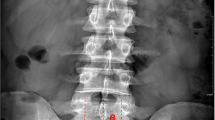Abstract
Purpose
Lumbar spondylolysis, a stress fracture of the pars interarticularis in the lumbar spine, is often precipitated by trauma, but there may be a congenital predisposition to this condition. There have been few studies on spondylolysis in young children, despite their suitability for studies on congenital defects. The aim of this study was to identify the clinical features of lumbar spondylolysis in elementary school age children in order to elucidate its pathogenesis.
Methods
Thirty lumbar spondylolysis patients (23 boys, 7 girls, including a pair of twins; mean age 9.5 years, age range 5–12 years) were studied. Patient data on history of athletic activity, symptoms at first consultation, and radiological findings such as spinal level, stage of the stress fracture, and skeletal age were collected.
Results
Among the 30 patients, 27 (21 boys, 6 girls) had L5 spondylolysis (90.0 %). Only 2 patients had no history of athletic activity at the first consultation. All patients, except for 2 whose diagnosis was incidental, complained of low back pain. In the 27 patients with L5 spondylolysis, 17 (63.0 %) had terminal-stage fracture and 25 (92.6 %) had spina bifida occulta (SBO) involving the S1 lamina. Sixteen of the 27 (59.3 %) had SBO involving the affected lamina (L5) and S1 lamina. In contrast, the 3 patients with L3 or L4 spondylolysis had no evidence of SBO. With respect to skeletal age, 23 of the 27 L5 spondylolysis patients (85.2 %) were in the cartilaginous stage while the remaining 4 patients were in the apophyseal stage.
Conclusion
Lumbar spondylolysis in elementary school age children was commonly a terminal-stage bone defect at L5, which was not necessarily related to history of athletic activity and was sometimes asymptomatic. It was often associated with SBO, indicating a possible congenital predisposition. These findings may provide further insight into the pathogenesis of lumbar spondylolysis.





Similar content being viewed by others
References
Wiltse LL, Widell EH Jr, Jackson DW (1975) Fatigue fracture: the basic lesion in isthmic spondylolisthesis. J Bone Joint Surg Am 57:17–22
Wiltse LL (1957) Etiology of spondylolisthesis. Clin Orthop Relat Res 10:48–59
Sakai T, Sairyo K, Takao S et al (2009) Incidence of lumbar spondylolysis in the general population in Japan based on multidetector computed tomography scans from two thousand subjects. Spine (Phila Pa 1976) 34:2346–2350
Sairyo K, Sakai T, Yasui N et al (2012) Conservative treatment for pediatric lumbar spondylolysis to achieve bone healing using a hard brace: what type and how long? Clinical article. J Neurosurg Spine 16:610–614
Sairyo K, Sakai T, Yasui N (2009) Conservative treatment of lumbar spondylolysis in childhood and adolescence: the radiological signs which predict healing. J Bone Joint Surg Br 91:206–209
Sairyo K, Katoh S, Takata Y et al (2006) MRI signal changes of the pedicle as an indicator for early diagnosis of spondylolysis in children and adolescents: a clinical and biomechanical study. Spine (Phila Pa 1976) 31:206–211
Sairyo K, Katoh S, Ikata T et al (2001) Development of spondylolytic olisthesis in adolescents. Spine J 1:171–175
Yamada A, Sairyo K, Shibuya I et al (2013) Lumbar spondylolysis in juveniles from the same family: a report of three cases and a review of the literature. Case Rep Orthop 2013:272514. doi:10.1155/2013/272514
Fredrickson BE, Baker D, McHolick WJ et al (1984) The natural history of spondylolysis and spondylolisthesis. J Bone Joint Surg Am 66:699–707
Fujii K, Katoh S, Sairyo K et al (2004) Union of defects in the pars interarticularis of the lumbar spine in children and adolescents. The radiological outcome after conservative treatment. J Bone Joint Surg Br 86:225–231
Turner PG, Green JH, Galasko CS (1989) Back pain in childhood. Spine (Phila Pa 1976) 14:812–814
Bhatia NN, Chow G, Timon SJ et al (2008) Diagnostic modalities for the evaluation of pediatric back pain: a prospective study. J Pediatr Orthop 28:230–233
Sakai T, Sairyo K, Suzue N et al (2010) Incidence and etiology of lumbar spondylolysis: review of the literature. J Orthop Sci 15:281–288
Goda Y, Sakai T, Sakamaki T et al (2014) Analysis of MRI signal changes in the adjacent pedicle of adolescent patients with fresh lumbar spondylolysis. Eur Spine J 23:1892–1895
Conflict of interest
All authors confirm that there are no conflicts of interest with people or organizations that could bias the nature of this report.
Author information
Authors and Affiliations
Corresponding author
Rights and permissions
About this article
Cite this article
Sakai, T., Goda, Y., Tezuka, F. et al. Characteristics of lumbar spondylolysis in elementary school age children. Eur Spine J 25, 602–606 (2016). https://doi.org/10.1007/s00586-015-4029-4
Received:
Revised:
Accepted:
Published:
Issue Date:
DOI: https://doi.org/10.1007/s00586-015-4029-4




